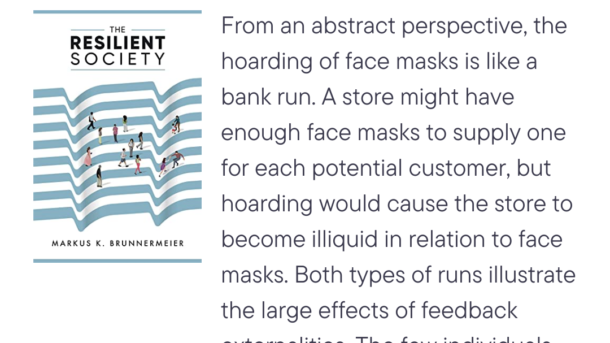Feedback, Trap Externalities, and Tipping Points Resilience, or the lack thereof, is often about how people react or are able to react to shocks. “Trap externalities” rob people of their resilience—their ability to bounce back after a shock. For example, if an employer fires a worker who subsequently cannot afford to send her children to school, her children’s potential will be severely compromised. The children will have almost no way to react to the shock. Such outcomes resemble the oak tree in Lafontaine’s fable. Once the oak tree has been uprooted by a storm, it dies. The reaction of someone who has been exposed to an externality can lead to destabilizing feedback loops and to weaker overall resilience. In other words, people might cumulatively inflict externalities onto each other and therefore cause a deterioration in the society’s equilibrium and resilience. We call those situations “feedback externalities.” A classic example is a bank run. If many bank customers withdraw their money on one day, they destabilize the bank and cause a negative externality. It the actions of those people incentivize others to withdraw money as well, more “feedback externalities” would ensue. Ultimately, this process could result in a full-blown bank run, which would force the bank to suspend withdrawals because banks typically would not have sufficient deposits. From an abstract perspective, the hoarding of face masks is like a bank run. A store might have enough face masks to supply one for each potential customer, but hoarding would cause the store to become illiquid in relation to face masks. Both types of runs illustrate the large effects of feedback externalities. The few individuals who cause a bank run or hoard masks can induce negative externalities on many other people. Economists attribute these types of feedbacks to so-called “strategic complementarities.” Hoarding behavior is illustrated graphically in figure 2-2. Suppose that some people, including person A, purchase more toilet paper than typically needed. As a result, there will be less toilet paper available for others, including person B in the figure below. Person B suffers from a negative externality. Observing this, others might infer that toilet paper is scarce, so they also purchase more toilet paper. Now person A suffers from an externality that he or she caused. As toilet paper becomes quite scarce, person A will hoard more and person B, in reaction, might also acquire more toilet paper. At some point, when all toilet paper has been purchased, the loop stops. Externalities combined with feedback loops are the real “resilience killers.”
This book honestly wasn’t the most exciting read, but I wanted to pick up some books that detailed more about Covid and its implications now that we are kinda in the post-Covid phase. This was one of the serendipitous ones I guess. This book generally is about applying a resilient framework, set in the backdrop of Covid and using it as a study to understand how societies can be more resilient in the face of crises, technological shifts and so on. For me, it wasn’t the most thrilling read because I find that books that try promoting and justifying a framework generally tend to be less interesting in general, but maybe its just personal preference and my lack of patience.
This is one of the more interesting passages though. Feedback loops and tipping point might kinda sound like basic shit, but its something that we tend to easily forget when considering our day to day actions. It also explains why things can get out of order pretty quickly, especially in the context of crises. Hence, why we could easily run out of things like toilet paper and it also tends to explain why most leaders choose to always promulgate calming and reassuring messages, sometimes overtly so. Like how governments initially stated that there were no need for face-masks at the onset of Covid. Reducing the negative feedback loop from a panicked public and minimising negative externalities was probably one of the biggest factors for the initial statements.



